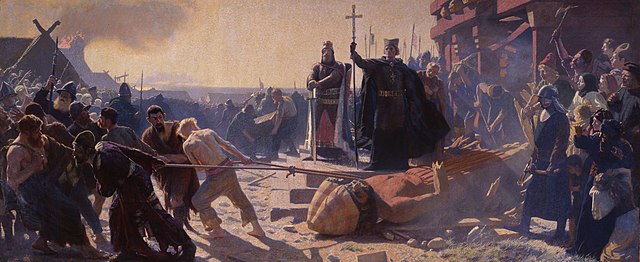Svetovit, Sventovit, Svantovit is the god of abundance and war, and the chief god of the Slavic tribe of the Rani, and later of all the Polabian Slavs. His organized cult was located on the island of Rügen, at Cape Arkona, where his main temple was also located. According to the descriptions of medieval chroniclers, the statue representing this god had four heads, a horn and a sword, and to the deity himself were dedicated a white horse, a saddle, a bit, a flag, and eagles. Once a year, after the harvest, a large festival was held in his honor. With the help of a horn and a horse belonging to the god, the priests carried out divinations, and at night the god himself rode a horse to fight his enemies. His name can be translated as "Strong Lord" or "Holy Lord". In the past it was often mistakenly believed that the cult of Svetovit originated from St. Vitus. Among scholars of Slavic mythology, Svetovit is often regarded as a Polabian hypostasis of Pan-Slavic god Perun. His cult was destroyed in 1168.

Divination before battle, Józef Ryszkiewicz, 1890
Remains of a fortress at Arkona. Shoreline destruction continues at a rate of 0.3-0.5 m per year.
The Taking of Arkona in 1169, King Valdemar and Bishop Absalon, Laurits Tuxen.
Old Prussian stone baba [Wikidata] in the courtyard of the Olsztyn Castle.
The Rani or Rujani were a West Slavic tribe based on the island of Rugia (Rügen) and the southwestern mainland across the Strelasund in what is today northeastern Germany.
A priest of Svantevit depicted on a stone from Arkona, now in the church of Altenkirchen.




![Old Prussian stone baba [Wikidata] in the courtyard of the Olsztyn Castle.](https://upload.wikimedia.org/wikipedia/commons/thumb/0/0d/Pruska_baba_Olsztyn.jpg/428px-Pruska_baba_Olsztyn.jpg)
